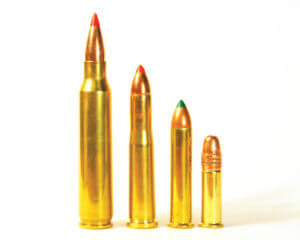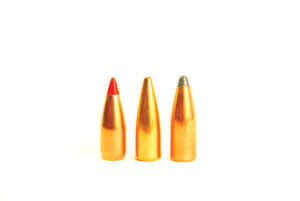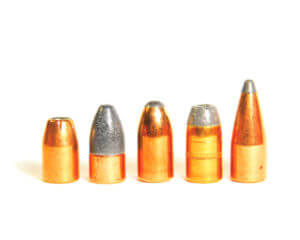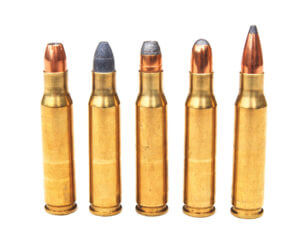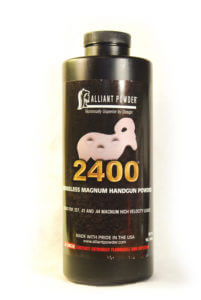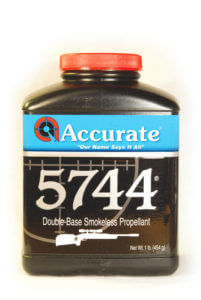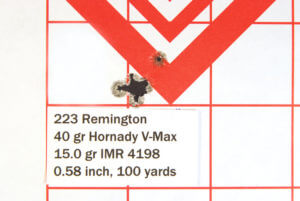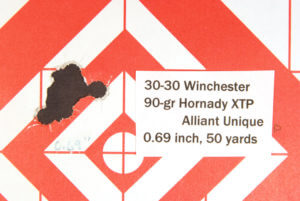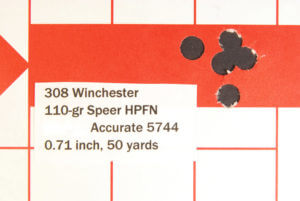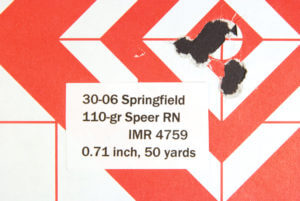IN ANY TYPE OF SURVIVAL SITUATION, SELF-SUFFICIENCY WITH A MINIMUM OF EQUIPMENT IS ESSENTIAL.

Being self-sufficient means being able to provide food, fire, shelter and mount an effective defense.
As a consequence, the necessary equipment for relatively long-term survival would normally include a firearm of some type. The intent here is not to make a case for a particular type of firearm but to show that one firearm can serve many purposes.
Historically, a vast number of explorers, adventurers, homesteaders and survivors have turned to a lever-action .30-30 (such as the Model 94 Winchester) as their only rifle. Actually, for use in a broad range of survival situations, it remains a good choice.
ONE RIFLE, MANY USES
Loading centerfire rifle ammunition with cast bullets was a common practice for many years. However, there is no reason that jacketed bullets cannot be loaded to velocities well below the maximum. Today, many shooters choose one rifle for small game, another for varmints and still another for animals the size of deer. Such a plethora of available calibers makes it very easy to assemble a sizeable arsenal of rifles for different uses.
But what if you must get by with just one rifle for all uses? The answer: sensible loading of different types of ammunition to take care of hunting both large and small game.

If one is forced to have only one rifle, it should be in a popular caliber, such as the .223 Remington, .308 Winchester, .30-06 Springfield or .30-30 Winchester, so that one is able to find readily available parts and ammunition. Despite their intended uses, the utility of these calibers can be greatly increased by loading the ammunition to different power levels.
For example, it is convenient to load the .223 Remington to duplicate the performance of a .22 LR, .22 WMR or .22 Hornet in addition to still having full-power loads. In the case of the .30-caliber rifles, loads can be prepared that duplicate some handgun calibers or even the .30 Carbine. Other calibers are also able to have their versatility increased by preparing appropriate ammunition. However, only a widely distributed caliber should be chosen for use when most sources of supplies have dried up.
As a result of careful loading, the usefulness of a centerfire rifle in a longterm survival situation can be increased. Older loading manuals list many reduced loads, especially those involving cast bullets. Such loads were widely used by shooters because there were far fewer calibers available, so a single rifle was loaded for multiple uses.
PREPARING LOW-POWER LOADS
Today, there are so many calibers available that it is not necessary to get by with just a single rifle. However, because so much emphasis is placed on obtaining the highest velocity possible, some modern loading manuals no longer show reduced loads. In essence, preparing reduced loads is like taking a step backward in time—but so are many survival skills.

Preparing low-power loads for centerfire rifles is a simple and economical process. Nevertheless, there are some extremely important issues that must be kept in mind when preparing them.
Reduced loads are never prepared by simply using a much smaller charge of the same powder used to prepare full-power loads! Most modern smokeless powders operate best within a certain pressure range, and full-power loads utilize a powder charge that fills most of the case. If a small charge of such a powder were used to prepare a reduced load, there would be a lot of air space; that might cause a phenomenon known as “detonation” to occur. As a result, instead of the pressure being lower than for a full-power load, it is actually much higher, possibly resulting in a catastrophic event.
The normal practice in producing lowpower loads is to use a small charge of a fastburning powder that will give a pressure sufficiently high for optimum burning but low enough to be safe. In many instances, such a powder charge occupies only a relatively small portion of the volume of the case.
Therefore, it is imperative that care be taken to make absolutely sure that multiple charges do not get loaded in the case! One sure way to do this is to have cases in the loading block neck down and to immediately insert a bullet in the case after the powder has been dispensed. If this procedure is followed every time, there will be no way that a double (or triple) charge can be loaded. Never leave a case upright with an open mouth in the loading block!
POWDER AND BULLETS
There are numerous powders suitable for preparing reduced loads for centerfire rifles. Some of the most popular are IMR 4759, Accurate 5744, IMR 4227 and Alliant 2400. In addition, several powders normally used for loading handgun cartridges are useful. One of the most popular is Alliant Unique, a powder that has been produced continuously for over a century. To some extent, the powder chosen depends on the power level to be achieved and the type of bullet used.
When it comes to bullet choices, the .223 Remington is somewhat more limited than the .30 calibers. Seldom are cast bullets of 0.224- inch diameter encountered, so the bullets used in reduced loads are almost always jacketed. However, such bullets with thin jackets are available for use at velocities of 2,000 feet per second or below, and they perform well.
Jacketed, plated and cast bullets are available for .30-caliber bullets. Some are intended for use in the .30 Carbines and work well at the relatively slow velocities obtained with reduced loads.
Moreover, Hornady offers a 90-grain XTP bullet that is intended primarily for .30-caliber handgun calibers, but it works very well in both the .30-30 and .308 Winchester. Hornady and Speer market 110-grain .308-inch-diameter bullets that have a short jacket on the rear portion of the bullet, and they are suitable for application in reduced loads.
Most reduced loads would be employed to take small game and pests. It is pointless to produce such loads for the .30-caliber cartridges using strongly constructed 150- to 180-grain bullets for large game, because they will not expand.
As for my needs, reduced loads for the .223 Remington involve two velocity ranges. First are the loads that run 1,200 to 1,800 feet per second (similar to .22 LR and .22 WMR loads), and both Hodgdon Titegroup and Alliant Unique have been tested in those loads. For loads in the 2,000 to 2,500 feet-per-second range (similar to 22 Hornet loads), powders tested include Alliant 2400, IMR 4759 and 4198, and Accurate 5744.
Reduced loads for the .30-30, .308 and .30-06 have been tested with several types of bullets, but three that have given excellent results are the Speer 110-grain round nose and 110-grain hollow point, and the Hornady 110- grain short jacket. Powders utilized in these loads are IMR 4759 and 4198, Alliant Unique and 2400, and Accurate 5744. When very small powder charges are used, some shooters use a filler such as Dacron, corn meal or cream of wheat to hold the powder charge close to the primer.
GREAT TEST RESULTS
The rifles chosen for testing the reduced loads were a Savage Axis .223 Remington, .30-30 Winchester Model 94, .308 Winchester Model 70 Featherweight and a .30-06 Remington Model 700.
I have tested all the loads and found that they perform well. In fact, the reduced loads gave outstanding accuracy; consequently, they would be suitable for taking small game or pests. Reduced loads clearly extend the usefulness of a centerfire rifle, and they provide valuable practice with the same rifle employed to hunt larger game.
I use a lot of reduced loads in my rifles when I don’t need full power. With the quantity of powder I use, 1 pound of propellant will load hundreds of rounds.
Although some shooters might select a different rifle when they want lower power, it is often advantageous to select lower-powered loads instead. Noise, muzzle blast and recoil are much more tolerable for the shooters and less offensive to others.
Editors Note: A version of this article first appeared in the March 2016 print issue of American Survival Guide.



